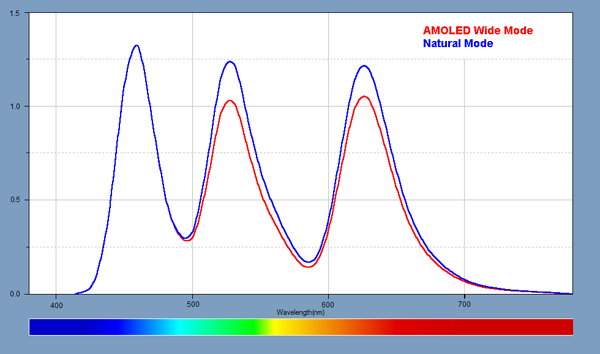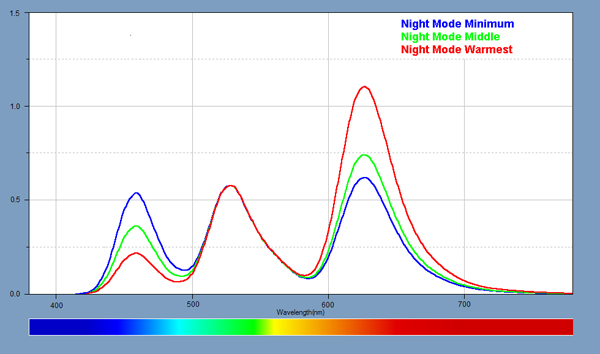LCD Displays have Backlights consisting of White LEDs, which are made by using a Blue LED together with a Yellow phosphor to transform some of the light for the Red and Green primaries. The spectrum of an LCD display is just the spectrum of its White LED Backlight filtered through the individual Red, Green and Blue sub-pixel color filters within the LCD panel, resulting in broad rolling spectra for LCDs.
OLED Displays are emissive devices so their spectra are just the sum of the individual Red, Green and Blue OLED spectra, modified slightly by the touchscreen layer and anti-reflection absorption layer through which their light must pass. As expected the OnePlus 7 Pro OLED spectra are relatively narrow with deep notches between the primaries, which results in highly saturated colors that are adjusted with display Color Management to provide high color accuracy for each of the Screen Calibration Modes.
The difference in the relative heights of the Green and Red Primary peaks for the user selectable AMOLED Wide and Natural Modes in Figure 5a below is due to their different White Point Color Temperatures, which requires different drive levels for each Primary Color. The AMOLED Wide Mode has a somewhat Bluish White Point, so it has reduced Green and Red drive levels.

The Night Mode is designed to change the color balance of the display in order to reduce the amount of Blue Light produced by the display, which some recent research indicates can affect how well users sleep afterwards. As the user adjustable Color Temperature setting is increased, the on-screen images take on an increasingly yellowish tint because amount of Blue Light emitted by the display decreases, which is seen in Figure 5b below. With the Night Mode turned On at its Warmest setting, the Blue Light component is reduced by 60 percent. Moving the Night mode Lightness slider to the Darkest setting further decreases the Blue Light by up to 85 percent.
In a separate article we provide an in-depth scientific analysis on the issues affecting Watching Displays at Night and their associated light spectra.
At the Middle setting the White Color Temperature decreases to 4,100 K, and at the Maximum setting it decreases to 2,730 K, the Color Temperature of traditional incandescent lighting, which is yellowish.
